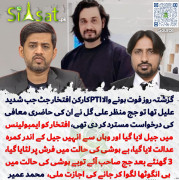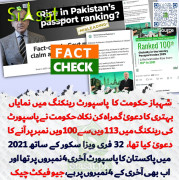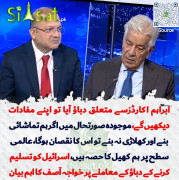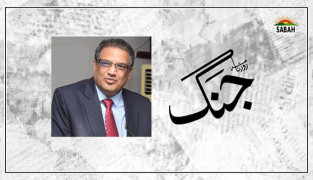[h=3]
Cyber Wars Across China, India and Pakistan[/h]
Last year at the World Economic Forum, U.S.-based security software firm McAfee's CEO Dave Walt reportedly told some
attendees that China, the United States, Russia, Israel and France are among 20 countries locked in a cyberspace arms race and gearing up for possible Internet hostilities. He further said that the traditional defensive stance of government computer infrastructures has shifted in recent years to a more offensive posture aimed at espionage, and deliberate disruption of critical networks in both government and private sectors. Such attacks could disrupt not only command and control for modern weapon systems such as ballistic missiles, but also critical civilian systems including banking, electrical grid, telecommunications, transportation, etc, and bring life to a screeching halt.
Richard Clark, the former US cyber security czar, explained in a
Newsweek interview the potential impact of cyber attacks on privately owned and operators infrastructure as follows:
"I think the average American would understand it if they suddenly had no electricity. The U.S. government, [National Security Administration], and military have tried to access the power grid's control systems from the public Internet. They've been able to do it every time they have tried. They have even tried to issue commands to see if they could get generators to explode. That's the famous Aurora experiment in Idaho. Well, it worked. And we know there are other real cases, like the power grid taken out in Brazil as part of a blackmail scheme. So the government knows it can be done, the government admits it can be done, the government intends to do it to other countries. Even the Chinese military has talked publicly about how they would attack the U.S. power grid in a war and cause cascading failures".

As if to confirm Walt's assertions, the Chinese hackers have allegedly stolen Indian national security information, 1,500 e-mails from the Dalai Lama’s office, and other sensitive documents, according to a
report released by researchers at the
University of Toronto.
Media reports also indicated that government, business, and academic computers at the United Nations and the Embassy of Pakistan in the US were also targets. The UofT report also indicated there was no evidence to suggest any involvement by the Chinese government, but it has put Beijing on the defensive. Similar reports earlier this year said security investigators had traced attacks on Google and other American companies to China-based computers.
Chinese hackers apparently succeeded in downloading source code and bugs databases from Google, Adobe and dozens of other high-profile companies using unprecedented tactics that combined encryption, stealth programming and an unknown hole in Internet Explorer, according to new details released by the anti-virus firm McAfee and reported by
Wired magazine. These hack attacks were disguised by the use of sophisticated encryption, and targeted at least 34 companies in the technology, financial and defense sectors, exploiting a vulnerability in Adobe’s Reader and Acrobat applications.
While the Chinese cyber attacks on US and India often get wide and deep coverage in the western media, a lower profile, small-scale cyber warfare is also raging in the shadows between India and Pakistan, according to some reports. These reports indicate that around 40-50 Indian sites are being attacked by Pakistani hackers on a daily basis whereas around 10 Pakistani sites are being hit by their Indian counterparts.
According to Pakistani blogger
Arsalan Jamshed, cyberwars between the two countries started in May 1998. Soon after India officially announced its first nuclear test, a group of hackers, believed to be Pakistani, called milw0rm broke into the Bhabha Atomic Research Center web site and posted anti-India and anti-nuclear messages. The cyberwars usually have been limited to defacing of each others' sites. Defacement causes only superficial damage, in which only the home page of a site is replaced with hacker's own page, usually with some message for the victim. Such defacements started in May 1998 and continued during Kargil War in 1999 and then during that era when the tension between India and Pakistan was at its peak from Dec 2001 to 2002. Therefore, the period between 1999 to 2002 was very crucial, when the troops were busy across the LOC exchanging fire and the hackers were busy in defacing each others' websites.
In 2003, Indian and Pakistani hackers attacked each others' servers using variants of
Yaha-Q email worm to shut down about 20 different applications, including personal firewalls and anti-virus software, according to Tony Magallanez, a system engineer with Finland-based F-Secure Corp.
Last year, there were
news reports of Indian cyber attacks on Pakistan's Oil and Gas Regularity Authority. In retaliation, some Pakistani attackers hacked the websites of the Indian Institute of Remote Sensing, the Center for Transportation Research and Management, the Army's Kendriya Vidyalaya of Ratlam and the Oil and Natural Gas Corporation (ONGC). In one particular instance, Pakistani hackers removed the "most wanted" list from the Indian state Andhra Pradesh's CID (criminal investigation department) website and replaced it with messages threatening their Indian cyber rivals.
Unwelcome computer intrusions by Pakistani hackers are not new. The nation has the dubious distinction of being the birth place of the first ever personal computer virus known to mankind. Popularly called the 'Brain virus', it was created in 1986 by two Pakistani brothers, Amjad and Basit Farooq Alvi. This virus, which spread via floppy disks, was known only to infect boot records and not computer hard drives like most viruses today. The virus also known as the Lahore, Pakistani, Pakistani Brain, Brain-A and UIUC would occupy unused space on the floppy disk so that it could not be used and would hide from detection. It would also disguise itself by displaying the uninfected bootsector on the disk.
Responding to the increasing threat perception of cyber attacks, the Indian Navy Chief Admiral Sureesh Mehta has called for leveraging Indian strengths in
Information Technology to build cyber warfare capabilities in India.
According to a
Times of India report last year, the Indian Army is boosting the cyber-security of its information networks right down to the level of divisions, which are field formations with over 15,000 troops.
In addition to creating cyber-security organization to protect against cyber attacks and data thefts, the Indian Army leaders have also underlined the urgent need for "periodic cyber-security audits" by India's Army Cyber Security Establishment (ACSE).
The Indian Army's actions are a response to reports that both China and Pakistan are bolstering their cyber-warfare or information warfare capabilities at a rapid clip.
While the India-Pakistan cyber conflict is at best the stuff of minor league, the real major league contest is likely to occur between the United States and its major adversaries, particularly China. The Pentagon already employs legions of elite hackers trained in cyberwarfare, according to a
Wired Magazine story in November, 2009. But they mostly play defense, and that's what Naval Postgraduate School professor John Arquilla wants to change. He'd like the US military's coders to team up with network specialists abroad to form a global geek squad. Together, they could launch preemptive online strikes to head off real-world battles.
Among other things, the
Wired magazine story had a scenario discussed by John Arquilla where an elite geek squad of world hackers could be used to prevent India-Pakistan nuclear war by taking out the command and control systems of both nations.
The increasing cyber attacks on U.S. government's networks and critical infrastructure, and the growing complexity of IT infrastructure, are driving a surge in federal cybersecurity spending; the U.S. federal government's total cumulative cybersecurity spending would be $55 billion between 2010 and 2015, according a report by
Homeland Security News Wire. At the same time, countries such as China and Russia recognize the fact that the United States has an unfair advantage over them in cyber warfare simply because most of the operating system and infrastructure software used in the world today has its origins in the United States. These concerns are fueling efforts by most major nations in the world to enhance their cyber security, and they are focusing on development of capacity to retaliate as a deterrence.
As to the potential cyber component of any future wars between India and Pakistan, its dramatic impact could reverberate across the globe as the computers used in South Asia for outsourced work from the United States and Europe come under crippling attacks from hackers on both sides. Here is how Robert X. Cringeley describes it in a June 2009 blog post captioned "
Collateral Damage":
"Forget for the moment about data incursions within the DC beltway, what happens when Pakistan takes down the Internet in India? Here we have technologically sophisticated regional rivals who have gone to war periodically for six decades. There will be more wars between these two. And to think that Pakistan or India are incapable or unlikely to take such action against the Internet is simply naive. The next time these two nations fight YOU KNOW there will be a cyber component to that war.
And with what effect on the U.S.? It will go far beyond nuking customer support for nearly every bank and PC company, though that’s sure to happen. A strategic component of any such attack would be to hobble tech services in both economies by destroying source code repositories. And an interesting aspect of destroying such repositories — in Third World countries OR in the U.S. — is that the logical bet is to destroy them all without regard to what they contain, which for the most part negates any effort to obscure those contents."







































